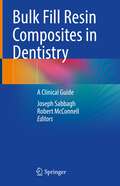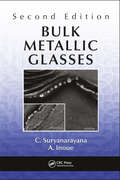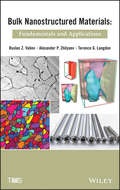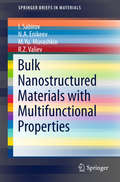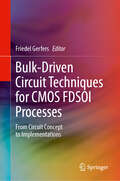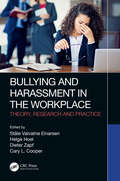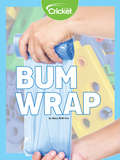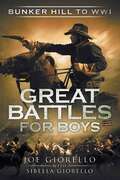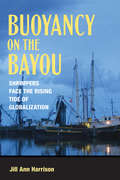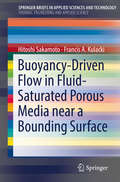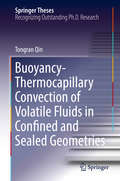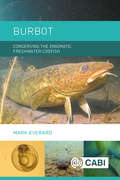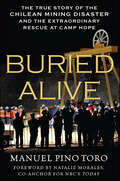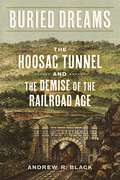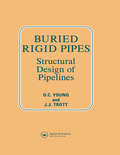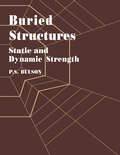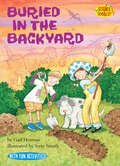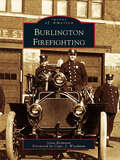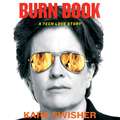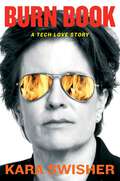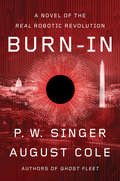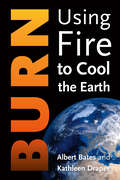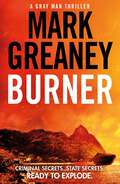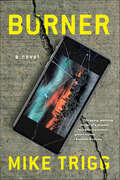- Table View
- List View
Bulk Fill Resin Composites in Dentistry: A Clinical Guide
by Robert McConnell Joseph SabbaghThis book is dedicated to all relevant aspects of bulk fill materials and their uses in clinical practice. Today, we count over 30 different bulk fill materials, which can be used in the dental clinic. The composition of bulk fill materials and their different modes of application for moderate to large direct resin restorations placement are explained in this book. It is written by a group of international specialists and allows the reader to evaluate available materials, learn predictable techniques and evaluate long term survival as well as future developments. The book covers all fields related to the history of bulk fill composites, their composition and physical properties, and a step by step guide to their successful clinical applications. Practitioners will find it invaluable as a clinical manual and a good reference book.
Bulk Metallic Glasses: 2002 Mrs Fall Meeting, Boston, Ma (Mrs Proceedings Ser. #754)
by C. Suryanarayana A. InoueReflecting the fast pace of research in the field, the Second Edition of Bulk Metallic Glasses has been thoroughly updated and remains essential reading on the subject. It incorporates major advances in glass forming ability, corrosion behavior, and mechanical properties. Several of the newly proposed criteria to predict the glass-forming ability of alloys have been discussed. All other areas covered in this book have been updated, with special emphasis on topics where significant advances have occurred. <P><P> These include processing of hierarchical surface structures and synthesis of nanophase composites using the chemical behavior of bulk metallic glasses and the development of novel bulk metallic glasses with high-strength and high-ductility and superelastic behavior. New topics such as high-entropy bulk metallic glasses, nanoporous alloys, novel nanocrystalline alloys, and soft magnetic glassy alloys with high saturation magnetization have also been discussed. Novel applications, such as metallic glassy screw bolts, surface coatings, hyperthermia glasses, ultra-thin mirrors and pressure sensors, mobile phone casing, and degradable biomedical materials, are described. Authored by the world’s foremost experts on bulk metallic glasses, this new edition endures as an indispensable reference and continues to be a one-stop resource on all aspects of bulk metallic glasses.
Bulk Nanostructured Materials
by Terence G. Langdon Alexander P. Zhilyaev Ruslan Z. ValievThis book presents the most recent results in the area of bulk nanostructured materials and new trends in their severe plastic deformation (SPD) processing, where these techniques are now emerging from the domain of laboratory-scale research into the commercial production of various bulk nanomaterials. Special emphasis is placed on an analysis of the effect of nanostructures in materials fabricated by SPD on mechanical properties (strength and ductility, fatigue strength and life, superplasticity) and functional behavior (shape memory effects, magnetic and electric properties), as well as the numerous examples of their innovative applications. There is a high innovation potential for industrial applications of bulk nanomaterials for structural use (materials with extreme strength) as well as for functional applications such as nanomagnets, materials for hydrogen storage, thermoelectric materials, superconductors, catalysts, and biomedical implants.
Bulk Nanostructured Materials with Multifunctional Properties (SpringerBriefs in Materials)
by I. Sabirov N. A. Enikeev M. Yu. Murashkin R. Z. ValievThis book presents a multifunctional approach to the design of bulk nanostructured metals through severe plastic deformation (SPD). Materials engineering has traditionally involved selecting a suitable material for a given application. However, modern engineering frequently requires materials with a set of multifunctional, often conflicting properties: Enhanced mechanical properties need to be combined with improved physical (electrical, magnetic, etc. ) and/or chemical (corrosion resistance, biocompatibility) properties. So disparate materials properties need to be engineered and optimized simultaneously. These requirements have created a paradigm shift in which the classical materials selection approach is replaced by design of material microstructures to achieve certain performance requirements, subject to constraints on individual properties such as strength, conductivity, and corrosion resistance. Written by researchers at the forefront of this new materials design approach, the present volume provides a comprehensive introduction to multifunctional design of bulk nanostructured materials, with applications ranging from hydrogen storage to construction engineering.
Bulk-Driven Circuit Techniques for CMOS FDSOI Processes: From Circuit Concept to Implementations
by Friedel GerfersIn the contemporary technology landscape dominated by digital-centric systems and applications, the significance of analog front-end signal processing remains indispensable. The precision and performance of critical analog, mixed-signal or mm-wave components such as low-noise amplifiers, equalizers, and data converters are fundamentally determined by technological parameters, such as transconductance, DC gain, device matching, linearity, and timing accuracy, among others. Enhancing these parameters through intrinsic design improvements presents a significant challenge and becomes infeasible beyond certain limits with state-of-the-art circuit design techniques. As the performance of CMOS transistors is fundamentally constrained, foreground or background calibration schemes are commonly employed to mitigate the limitations of MOS devices. However, these constraints can be effectively addressed through the implementation of active and passive bulk-driven circuits enabled by silicon-on-insulator (SOI) CMOS technologies. Fully-Depleted Silicon-on-Insulator (FD-SOI) CMOS technologies offer superior transistor characteristics compared to standard bulk CMOS technology, providing enhanced electrical performance, improved power efficiency, and better scalability. This book offers a comprehensive analysis of FD-SOI CMOS technology, presenting key innovations in design methodologies and circuit implementations adopting bulk-biasing techniques across analog, digital, mixed-signal, and mmWave circuits and systems. It addresses critical transistor limitations, including finite transistor gain, offset, mismatch, noise and linearity, among others. The authors provide detailed technical insights, mathematical modelling, design approaches and circuit realizations covering circuit advances using both static and dynamic transistor body-biasing techniques. Emphasis is placed on overcoming state-of-the-art circuit limitations such as finite DC gain, bandwidth, matching/accuracy and power efficiency. These performance metrics are rigorously investigated through mathematical modelling, validated through simulation and experimentally demonstrated using both dynamic and static body-biasing architectures.
Bullying and Harassment in the Workplace: Theory, Research and Practice
by Cary L. Cooper Helge Hoel Ståle Valvatne Einarsen Dieter ZapfBuilding on the success of two earlier best-selling editions from 2003 and 2011, this benchmark text and highly cited reference work now appears in its third edition. This book is a research-based resource on key aspects of workplace bullying and its remediation, which: Covers the nature and complexities of bullying and harassment in the workplace Presents the evidence on its prevalence, risk groups, antecedents and outcomes Examines cyberbullying and harassment in the digital world Describes the roles of bystanders and the coping possibilities of victims Discusses prevention, intervention, treatment and the management of specific cases Explains legal perspectives, the role of HR and of internal policies Edited by leading experts in the field and presenting contributions from subject experts, it provides state-of-the-art reviews of the main themes in the field, as well as practical remedies and solutions at individual, organizational and societal levels, providing a much-needed update and expansion of the original work, as the research and literature on this problem with its manifold detrimental effects has expanded radically over the last decade. This book should be of interest to all scholars in the field of organizational behavior and social processes at work. In particular, the book is a much-needed tool for bachelor, master and PhD students, new and experienced researchers in the field, advanced practitioners and policy makers, including labor inspectors, union representatives, HR-personnel, lawyers, management consultants, and counsellors in private practice, family physicians and occupational health practitioners, to name a few.
Bum Wrap
by Mary Beth CoxPlastic was once considered the material of the future, but now it has become a nuisance that results in too much trash for the planet to handle. Learn about the durability and longevity of this 19th-century invention and hear recycling ideas from a chemist who hopes to salvage plastic's reputation.
Bunker Hill to WW I (Great Battles for Boys)
by Joe GiorelloIn chronological order, beginning with the Revolutionary War, Great Battles for Boys: Bunker Hill to WWI takes young readers to the front lines of American history's most thrilling clashes. Boys discover the raw truth about the colonial fight for freedom, the hardships of Civil War soldiers, the fierce battle of the Alamo, the American Expeditionary Forces winning World War I, and much more!
Buoyancy Effects on Natural Ventilation
by Torwong ChenvidyakarnThis book describes in depth the fundamental effects of buoyancy, a key force in driving air and transporting heat and pollutants around the interior of a building. This book is essential reading for anyone involved in the design and operation of modern sustainable, energy-efficient buildings, whether a student, researcher or practitioner. The book presents new principles in natural ventilation design and addresses surprising, little-known natural ventilation phenomena that are seldom taught in architecture or engineering schools. Despite its scientific and applied mathematics subject, the book is written in simple language and contains no demanding mathematics, while still covering both qualitative and quantitative aspects of ventilation flow analysis. It is therefore suitable for both non-expert readers who just want to develop intuition of natural ventilation design and control (such as architects and students) and for those possessing more expertise whose work involves quantifying flows (such as engineers and building scientists).
Buoyancy on the Bayou: Shrimpers Face the Rising Tide of Globalization
by Jill Ann HarrisonOver the past several decades, shrimp has transformed from a luxury food to a kitchen staple. While shrimp-loving consumers have benefited from the lower cost of shrimp, domestic shrimp fishers have suffered, particularly in Louisiana. Most of the shrimp that we eat today is imported from shrimp farms in China, Vietnam, and Thailand. The flood of imported shrimp has sent dockside prices plummeting, and rising fuel costs have destroyed the profit margin for shrimp fishing as a domestic industry. In Buoyancy on the Bayou, Jill Ann Harrison portrays the struggles that Louisiana shrimp fishers endure to remain afloat in an industry beset by globalization. Her in-depth interviews with more than fifty individuals working in or associated with shrimp fishing in a small town in Louisiana offer a portrait of shrimp fishers' lives just before the BP oil spill in 2010, which helps us better understand what has happened since the Deepwater Horizon disaster. Harrison shows that shrimp fishers go through a careful calculation of noneconomic costs and benefits as they grapple to figure out what their next move will be. Many willingly forgo opportunities in other industries to fulfill what they perceive as their cultural calling. Others reluctantly leave fishing behind for more lucrative work, but they mourn the loss of a livelihood upon which community and family structures are built. In this gripping account of the struggle to survive amid the waves of globalization, Harrison focuses her analysis at the intersection of livelihood, family, and community and casts a bright light upon the cultural importance of the work that we do.
Buoyancy-Driven Flow in Fluid-Saturated Porous Media near a Bounding Surface (SpringerBriefs in Applied Sciences and Technology)
by Francis A. Kulacki Hitoshi SakamotoThis Brief reports on heat transfer from a solid boundary in a saturated porous medium. Experiments reveal overall heat transfer laws when the flow along the wall is driven by buoyancy produced by large temperature differences, and mathematical analysis using advanced volume-averaging techniques produce estimates of how heat is dispersed in the porous zone. Engineers, hydrologists and geophysicists will find the results valuable for validation of laboratory and field tests, as well as testing their models of dispersion of heat and mass in saturated media.
Buoyancy-Thermocapillary Convection of Volatile Fluids in Confined and Sealed Geometries (Springer Theses)
by Tongran QinThis thesis represents the first systematic description of the two-phase flow problem. Two-phase flows of volatile fluids in confined geometries driven by an applied temperature gradient play an important role in a range of applications, including thermal management, such as heat pipes, thermosyphons, capillary pumped loops and other evaporative cooling devices. Previously, this problem has been addressed using a piecemeal approach that relied heavily on correlations and unproven assumptions, and the science and technology behind heat pipes have barely evolved in recent decades. The model introduced in this thesis, however, presents a comprehensive physically based description of both the liquid and the gas phase. The model has been implemented numerically and successfully validated against the available experimental data, and the numerical results are used to determine the key physical processes that control the heat and mass flow and describe the flow stability. One of the key contributions of this thesis work is the description of the role of noncondensables, such as air, on transport. In particular, it is shown that many of the assumptions used by current engineering models of evaporative cooling devices are based on experiments conducted at atmospheric pressures, and these assumptions break down partially or completely when most of the noncondensables are removed, requiring a new modeling approach presented in the thesis. Moreover, Numerical solutions are used to motivate and justify a simplified analytical description of transport in both the liquid and the gas layer, which can be used to describe flow stability and determine the critical Marangoni number and wavelength describing the onset of the convective pattern. As a result, the results presented in the thesis should be of interest both to engineers working in heat transfer and researchers interested in fluid dynamics and pattern formation.
Burbot: Conserving the Enigmatic Freshwater Codfish
by Mark EverardThe burbot has a unique ecology as the only member of the order of cod-like fishes found in freshwater. It is the second most widely distributed freshwater fish in the Northern Hemisphere, variously threatened, extinct or thriving across different parts of this wide Palaearctic range. Burbot were driven to extinction from Britain most probably in the 1970s, the last recorded specimen caught in 1969 in Cambridgeshire. Particularly over the past decade, a large body of work has addressed potential reintroduction of the burbot to Britain. The burbot's diverse habitat and other needs throughout its life stages also mean that the species is a flagship for a diversity of other wildlife of restored river systems, and of the human benefits that these ecosystems can provide. Burbot is an excellent source for all those involved in freshwater fish and fisheries management, conservation and exploitation, including fish biologists (ichthyologists), environmental scientists, freshwater biologists, fisheries managers and scientists, conservation biologists, engineers and hydrologists. The libraries of all universities and research establishments where these subjects are studied and taught should have a copy. Anglers and all those interested in fishes and natural history will also benefit from this book.
Buried Alive: The True Story of the Chilean Mining Disaster and the Extraordinary Rescue at Camp Hope
by Manuel Pino ToroThe inside story of the thirty-three Chilean miners trapped 2,300 feet underground that captivated the worldOn August 5, 2010, a tunnel in the gold and copper mine in the Atacama Desert in Chile collapsed, with all of its miners trapped underground. For days, the families waited breathlessly as percussion drills searched out signs of life. Finally, a note came back from below--the miners were alive and safe. Now the rescue crew needed to burrow through 2300 feet of solid rock to get them out. For nine weeks, the world watched as Chile threw all of its resources into the effort. Televisions flashed images of worried families holding vigil night and day and of Chile's newly elected President Pinera making their recovery his personal crusade. What the cameras didn't reveal was the behind-the-scenes intrigue: the corruption that led to faulty construction of the tunnel in the first place; how the men lived in a muddy and humid environment where the temperature was unbearably hot; how the rescue effort became a political campaign to raise the president's sagging numbers; and the abundant hope necessary to sustain the men in their underground captivity. Author Manuel Pino takes us into his native Chile and, drawing on direct access to the miners and their families, weaves a rich narrative of extraordinary survival and triumph.
Buried Dreams: The Hoosac Tunnel and the Demise of the Railroad Age
by Andrew R. BlackThe Hoosac railroad tunnel in the mountains of northwestern Massachusetts was a nineteenth-century engineering and construction marvel, on par with the Brooklyn Bridge, Transcontinental Railroad, and Erie Canal. The longest tunnel in the Western Hemisphere at the time (4.75 miles), it took nearly twenty-five years (1851‒1875), almost two hundred casualties, and tens of millions of dollars to build. Yet it failed to deliver on its grandiose promise of economic renewal for the commonwealth, and thus is little known today. Andrew R. Black’s Buried Dreams refreshes public memory of the project, explaining how a plan of such magnitude and cost came to be in the first place, what forces sustained its completion, and the factors that inhibited its success. Black digs into the special case of Massachusetts, a state disadvantaged by nature and forced repeatedly to reinvent itself to succeed economically. The Hoosac Tunnel was just one of the state’s efforts in this cycle of decline and rejuvenation, though certainly the strangest. Black also explores the intense rivalry among Eastern Seaboard states for the spoils of western expansion in the post‒Erie Canal period. His study interweaves the lure of the West, the competition between Massachusetts and archrival New York, the railroad boom and collapse, and the shifting ground of state and national politics. The psychic makeup of Americans before and after the Civil War heavily influenced public perceptions of the tunnel; by the time it was finished, Black contends, the indomitable triumphalism that had given birth to the Hoosac had faded to skepticism and cynicism. Anticipated economic benefits never arrived, and Massachusetts eventually sold the tunnel for only a fraction of its cost to a private railroad company.Buried Dreams tells a story of America’s reckoning with the perils of impractical idealism, the limits of technology to bend nature to its will, and grand endeavors untempered by humility.
Buried Rigid Pipes
by OC Young JJ TrottThis book is specifically concerned with pipes of rigid materials and provides some information on 'flexible' pipes that are available and on their behaviour and use as being of value to the engineer in making an initial choice.
Buried Structures: Static and Dynamic Strength
by Dr P BulsonMuch of the infrastructure of modern society is buried below ground. Pipeline, conduits and culverts carry the services on which our economies depend and the strength and resilience of such structures is of vital importance. Larger underground construction is becoming more common in cities and towns, and in defence installations. This book brings t
Buried in the Backyard (Science Solves It!)
by Gail HermanSolve kid-sized dilemmas and mysteries with the Science Solves It! series. These fun science books for kids ages 5–8 blend clever stories with real-life science. Why did the dog turn green? Can you control a hiccup? Is that a UFO? Find the answers to these questions and more as kid characters dive into physical, life, and earth sciences. While trying to dig a pool for themselves, Ryan and Kate discover a very large, old bone-right in their own backyard! Amazingly, it turns out to be the fossilized bone of a Woolly Mammoth! Books in this perfect STEM series will help kids think like scientists and get ahead in the classroom. Activities and experiments are included in every book! (Level One; Science topic: Woolly Mammoths)
Burlington Firefighting (Images of America)
by Liisa Reimann Capt. J. WoodmanBurlington Firefighting richly illustrates the triumphs and tragedies, the hauntings and secrets of the Burlington Fire Department. Originating as a series of bucket brigades, the fire department developed from competing companies that served as elite social clubs into a professional organization that was incorporated in 1895. The transitions from hand-drawn to horse-drawn carts and pumpers to steam engines and motorized trucks largely shaped the evolution of firefighting in Vermont as a whole.
Burn Book
by Kara SwisherFrom award-winning journalist Kara Swisher comes a witty, scathing, but fair accounting of the tech industry and its founders who wanted to change the world but broke it instead.While tech titans bragged they would 'move fast and break things', Kara Swisher was moving faster and breaking news. Covering the explosion of the digital sector in the early 1990s, she developed a long track record of digging up and reporting the truth of this new world order. Her consistent scoops drove one CEO to accuse her of "listening in the heating ducts" and for Facebook's Sheryl Sandberg to once say: 'It is a constant joke in the Valley when people write memos for them to say, "I hope Kara never sees this."'Burn Book is part memoir, part history and, most of all, a necessary recounting of tech's most powerful players. This is the inside story we've all been waiting for of modern Silicon Valley and the biggest boom in wealth creation in the history of the world.While still in college, Swisher got her start at The Washington Post, where she became one of the few people in journalism interested in the emerging field of tech. She was among the first to recognize the potential of the internet, accurately predicting that 'everything that could be digitized, would be digitized.' She went on to work for The Wall Story Journal, joining with Walt Mossberg to start the groundbreaking AllThingsD conference, as well as pioneering online tech sites.It's only a slight exaggeration to say Swisher has interviewed everyone. Steve Jobs, Jeff Bezos, Elon Musk, Bill Gates, Bob Iger, Larry Page and Sergey Brin, Meg Whitman, Peter Thiel, and Mark Zuckerberg are just a few who Swisher made sweat-figuratively and, in one famous case, literally.Despite the damage she chronicles, Swisher remains optimistic about tech's potential to help solve problems and not just create them. She calls upon the industry to make better, more thoughtful choices, even as a new set of powerful AI tools are poised to change the world yet again. At its heart, this book is a love story to, for, and about tech from someone who knows it better than anyone.Burn Book includes soaring tales of innovation and brilliant entrepreneurs, as well as Silicon Valley's much more complex history of striving, success, and failure. The book details how the commercial internet came into being and how, for all it has given the world, it now sits at the center of global power, creating a clear and present danger to humanity.
Burn Book
by Kara SwisherFrom award-winning journalist Kara Swisher comes a witty, scathing, but fair accounting of the tech industry and its founders who wanted to change the world but broke it instead.While tech titans bragged they would 'move fast and break things', Kara Swisher was moving faster and breaking news. Covering the explosion of the digital sector in the early 1990s, she developed a long track record of digging up and reporting the truth of this new world order. Her consistent scoops drove one CEO to accuse her of "listening in the heating ducts" and for Facebook's Sheryl Sandberg to once say: 'It is a constant joke in the Valley when people write memos for them to say, "I hope Kara never sees this."'Burn Book is part memoir, part history and, most of all, a necessary recounting of tech's most powerful players. This is the inside story we've all been waiting for of modern Silicon Valley and the biggest boom in wealth creation in the history of the world.While still in college, Swisher got her start at The Washington Post, where she became one of the few people in journalism interested in the emerging field of tech. She was among the first to recognize the potential of the internet, accurately predicting that 'everything that could be digitized, would be digitized.' She went on to work for The Wall Story Journal, joining with Walt Mossberg to start the groundbreaking AllThingsD conference, as well as pioneering online tech sites.It's only a slight exaggeration to say Swisher has interviewed everyone. Steve Jobs, Jeff Bezos, Elon Musk, Bill Gates, Bob Iger, Larry Page and Sergey Brin, Meg Whitman, Peter Thiel, and Mark Zuckerberg are just a few who Swisher made sweat-figuratively and, in one famous case, literally.Despite the damage she chronicles, Swisher remains optimistic about tech's potential to help solve problems and not just create them. She calls upon the industry to make better, more thoughtful choices, even as a new set of powerful AI tools are poised to change the world yet again. At its heart, this book is a love story to, for, and about tech from someone who knows it better than anyone.Burn Book includes soaring tales of innovation and brilliant entrepreneurs, as well as Silicon Valley's much more complex history of striving, success, and failure. The book details how the commercial internet came into being and how, for all it has given the world, it now sits at the center of global power, creating a clear and present danger to humanity.
Burn-In: A Novel of the Real Robotic Revolution
by P. W. Singer August ColeAn FBI agent hunts a new kind of terrorist through a Washington, DC, of the future in this groundbreaking book - at once a gripping technothriller and a fact-based tour of tomorrow America is on the brink of a revolution, one both technological and political. The science fiction of AI and robotics has finally come true, but millions are angry and fearful that the future has left them behind. After narrowly stopping a bombing at Washington&’s Union Station, FBI Special Agent Lara Keegan receives a new assignment: to field-test an advanced police robot. As a series of shocking catastrophes unfolds, the two find themselves investigating a conspiracy whose mastermind is using cutting-edge tech to rip the nation apart. To stop this new breed of terrorist, their only hope is to forge a new type of partnership.Burn-In is especially chilling because it is something more than a pulse-pounding read: every tech, trend, and scene is drawn from real world research on the ways that our politics, our economy, and even our family lives will soon be transformed. Blending a techno-thriller&’s excitement with nonfiction&’s insight, Singer and Cole illuminate the darkest corners of the world soon to come.
Burn: Igniting a New Carbon Drawdown Economy to End the Climate Crisis
by Albert Bates Kathleen Draper&“A brilliant, climatic coup that uplifts biochar to an entirely new level of substance and urgency!&”―Paul HawkenHow we can harness carbon to help solve the climate crisis in order to rescue ourselves from climate catastropheIn order to rescue ourselves from climate catastrophe, we need to radically alter how humans live on Earth. We have to go from spending carbon to banking it. We have to put back the trees, wetlands, and corals. We have to regrow the soil and turn back the desert. We have to save whales, wombats, and wolves. We have to reverse the flow of greenhouse gases and send them in exactly the opposite direction: down, not up. We have to flip the carbon cycle and run it backwards. For such a revolutionary transformation we&’ll need civilization 2.0.A secret unlocked by the ancients of the Amazon for its ability to transform impoverished tropical soils into terra preta—fertile black earths—points the way. The indigenous custom of converting organic materials into long lasting carbon has enjoyed a reawakening in recent decades as the quest for more sustainable farming methods has grown. Yet the benefits of this carbonized material, now called biochar, extend far beyond the soil. Pyrolyzing carbon has the power to restore a natural balance by unmining the coal and undrilling the oil and gas. Employed to its full potential, it can run the carbon cycle in reverse and remake Earth as a garden planet.Burn looks beyond renewable biomass or carbon capture energy systems to offer a bigger and bolder vision for the next phase of human progress, moving carbon from wasted sources:• Into soils and agricultural systems to rebalance the carbon, nitrogen, and related cycles; enhance nutrient density in food; rebuild topsoil; and condition urban and agricultural lands to withstand flooding and drought• To cleanse water by carbon filtration and trophic cascades within the world&’s rivers, oceans, and wetlands• To shift urban infrastructures such as buildings, roads, bridges, and ports, incorporating drawdown materials and components, replacing steel, concrete, polymers, and composites with biological carbon• To drive economic reorganization by incentivizing carbon drawdownFully developed, this approach costs nothing—to the contrary, it can save companies money or provide new revenue streams. It contains the seeds of a new, circular economy in which energy, natural resources, and human ingenuity enter a virtuous cycle of improvement. Burn offers bold new solutions to climate change that can begin right now.An 800-CEO-READ "Editor's Choice" March 2019
Burner (Gray Man #12)
by Mark GreaneyYou've seen the worldwide #1 Netflix film - now read the latest breathtaking Gray Man thrillerCourt Gentry is caught between the Russian mafia and the CIA in the new novel from the new king of the electrifying non-stop action thriller.When you kick over a rock, you never know what's going to crawl out. Alex Velesky is about to discover that the hard way. He's stolen records from the Swiss bank that employs him, thinking that he'll uncover a criminal conspiracy. But he soon finds that he's tapped into the mother lode of corruption. Before he knows it, he's being hunted by everyone from the Russian mafia to the CIA. Court Gentry and his erstwhile lover, Zoya Zakharova, find themselves on opposites poles when it comes to Velesky. They both want him but for different reasons. That's a problem for tomorrow. Today they need to keep him and themselves alive. Right now, it's not looking good.
Burner: A Novel
by Mike Trigg“An informed, interesting, and well-paced novel set in a world very similar to our own, Mike Trigg’s Burner is a cautionary tale for the digital age.”—IndieReader, IR Approved Inspired by the explosive events of our polarized political climate, Burner is an all-too plausible contemporary thriller that examines the social and personal consequences of the lost sense of identity, trust, and truth itself that characterizes our technology-obsessed culture. Shane Stoller has just been arrested for domestic terrorism, accused of being the mastermind behind the online profile Burner_911—the anonymous leader of a massive populist movement. Chloe Corbin has just been abducted by Burner_911’s followers in a lawless uprising on the streets of San Francisco, targeted as the socialite daughter of a tech billionaire. What nobody knows is that Shane and Chloe are secretly in love despite coming from opposite worlds. Plagued with regret but unable to communicate with his followers from prison, Shane tries desperately to find a way to save Chloe from the forces he has unleashed. From her own captivity, Chloe becomes more sympathetic to Burner_911’s cause—and transitions from victim to conspirator in an effort to free herself and exonerate Shane. Part tragic love story, part mind-bending psychological thriller, Burner dives headfirst into the modern zeitgeist of politically motivated disinformation, toxic internet subcultures, and our continuing need for belonging, purpose, and love in an age of distorted online personas.
